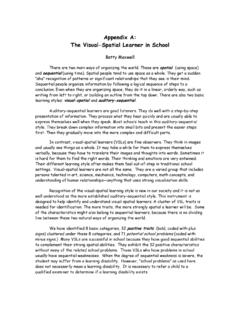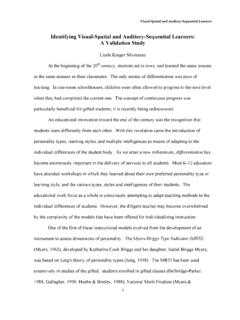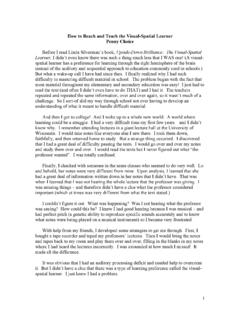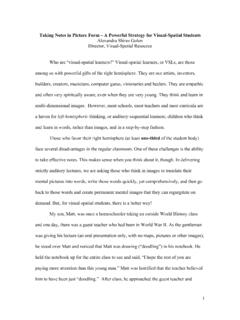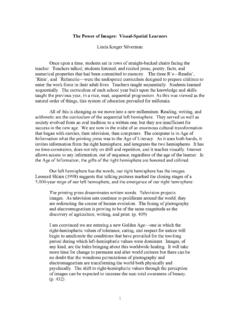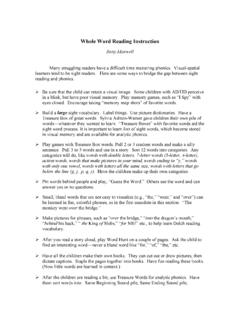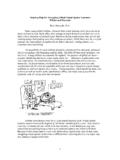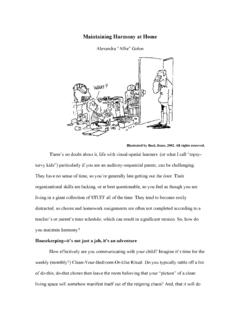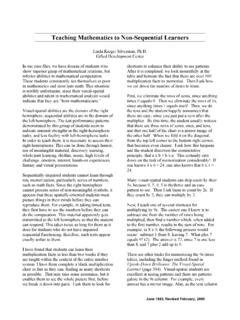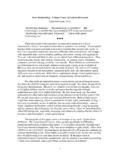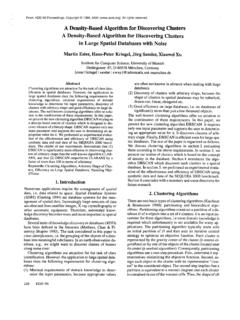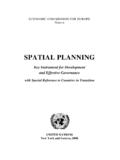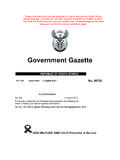Transcription of Teaching Reading to Visual-Spatial Learners
1 Teaching Reading to Visual-Spatial Learners Alexandra Shires Golon Illustrated by Buck Jones, 2002. Do not use without permission. Visual-Spatial Learners (VSLs) are our artists, inventors, builders, creators, musicians, computer gurus, visionaries and healers. They are empathic and, often, very spiritually aware, even when very young. These children have powerful right hemispheres and learn in multi-dimensional images, while most schools, most teachers and most curricula are a haven for left-hemispheric thinking, or auditory-sequential Learners ; children who think and learn in words, rather than images, and in a step-by-step fashion.
2 Though Visual-Spatial students are often very bright, they don t always find success in academic environments. Those who favor the right hemisphere of their brains, kids I refer to as topsy-turvy, are at a disadvantage in traditional classrooms. One of the many challenges they face is learning to read. In today s schools, most children are taught to read using a phonetic approach. However, for the Visual-Spatial learner (VSL), this is counter-intuitive to how they think and learn. Many VSLs have a hard time with phonics because the strategy is to teach Reading by breaking down words into their smallest sounds like: ra, ta, ga, and fa.
3 Then, you are to build on those small sounds to form whole words. visual -spatials understand big picture information first, not the smallest details! Because VSLs think in pictures, they need to read in pictures. What is the picture of ga ? Or of the? Can you create a mental picture of the ? But when VSLs are taught to read by looking at whole words first, not the smallest sounds, they can easily create mental pictures for those words and learn them permanently. A beginning reader can make mental pictures for numerous sight words and often, the more difficult the words, the better.
4 There is a distinction in the shape of the letters that form xylophone or Disneyland, that the Visual-Spatial won t find when Reading the word, an . Some words just naturally make you think of a picture because of the shape the letters make; like the letters M and N do in the word MouNtaiN. Or rain when you add a raindrop to dot the i like my son did for me. Your beginning readers can probably think of many more ways to draw words that include pictures. For words that they can t create a picture for (like an, or the ), they can make a picture of the word by shaping it out of string, Wikki Stix, or clay.
5 Some schools use letters made out of sandpaper so the student can trace over the shape of the letter with a finger. Any of these techniques will help to create mental images of the new words they are learning to read. Whole words can be placed on large index cards and hung from a key chain or stored in a special word box. Then, the beginning reader can practice sorting all the words with similar starting sounds, similar ending sounds or other categories they think up. This is called, analytic phonics, and will help any reader become even better.
6 Speed Reading I have one huge tip for Visual-Spatial Learners regarding Reading : speed read! Just like beginning readers have no need for picture-less words such as the, and, like, and so on, the child who is ready to progress in Reading isn t creating pictures for these words, either. So, just skip them! Have your Visual-Spatial children practice running their fingers, very quickly, over one line of words, then the next. Teach them to just jump right over the words that their mind doesn t have a picture for. Here s an example.
7 First, read this sentence: Then, on the following morning, Jody ran to the nearby grocery store to fetch a gallon of fresh milk for his mother. Now, watch how much easier you can make Reading this line by skipping over the words that have no mental picture, by Reading only the words that create an image in your mind: Morning, Jody ran store gallon milk for mother. Can you do it? Can you skip the picture-less words? Was it easier? Are you missing any facts from the first sentence? Does the sentence with much fewer words still make a picture in your mind of what the character is doing, when and for whom?
8 You don t even need the adjective fresh because you know he s buying it that morning, right? Isn t it easier to make a mental picture when you don t have to stop and read the picture-less words? The next time your kids have a Reading assignment, try speed Reading with them and see if it helps speed the process yet aid in remembering all the details. If your children need help recalling the pictures they are mentally creating, have them keep notes, as actual drawings. They should do this in the margins, if it s their book or in a separate notebook if the book does not belong to them.
9 Really important information such as the plot of the story, or dates of information, or names of characters they are studying, should be included in their drawings. Re- Reading for important information Remember Reading your own schoolbooks and saying to yourself, Whoa, I know that s gonna be on the test ? Did you know this because what you just read had a name or date or definition or because it was printed in bold or italic letters? When I was in school, I used to fold the corners of the pages that had this kind of important information which got me in hot water because the book had to be used again the next year and the pages would already be dog-eared.
10 Today s office supply stores offer so many great products including sticky Post-It tabs that come in a variety of colors. Show your kids how to use them to mark the exact line on a page of the important information they just read. They can stick them right on the line of the text, with the colored tab sticking out off the side of the page. This way, they can easily find the exact line they need to remember. They should use certain colored tabs for certain types of information. Maybe green tabs are for dates they have to remember? Or blue tabs for names?
